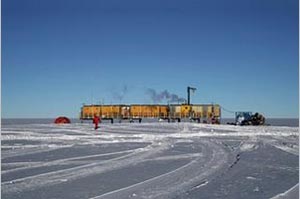Stardust in the Antarctic snow provides information on the environment of the solar system

In der Nähe der Kohnen-Station der Antarktis wurden Schneeproben entnommen, die an der TUM untersucht wurden. (Bild: S. Kipfstuhl / AWI - frei fuer Berichterstattung ueber TU Muenchen)
The quantity of cosmic dust that trickles down to Earth each year ranges between several thousand and ten thousand tons. Most of the tiny particles come from asteroids or comets within our solar system.
However, a small percentage comes from distant stars. There are no natural terrestrial sources for the iron-60 isotope contained therein; it originates exclusively as a result of supernova explosions or through the reactions of cosmic radiation with cosmic dust.
Antarctic snow travels around the world
The first evidence of the occurrence of iron-60 on Earth was discovered in deep-sea deposits by a TUM research team 20 years ago. Among the scientists on the team was Dr. Gunther Korschinek, who hypothesized that traces of stellar explosions could also be found in the pure, untouched Antarctic snow.
In order to verify this assumption, Dr. Sepp Kipfstuhl from the Alfred Wegener Institute collected 500 kg of snow at the Kohnen Station, a container settlement in the Antarctic, and had it transported to Munich for analysis.
There, a TUM team melted the snow and separated the meltwater from the solid components, which were processed at the Helmholtz-Zentrum Dresden-Rossendorf (HZDR) using various chemical methods, so that the iron needed for the subsequent analysis was present in the milligram range, and the samples could be returned to Munich.
Korschinek and Dominik Koll from the research area Nuclear, Particle and Astrophysics at TUM found five iron-60 atoms in the samples using the accelerator laboratory in Garching near Munich. “Our analyses allowed us to rule out cosmic radiation, nuclear weapons tests or reactor accidents as sources of the iron-60,” states Koll. “As there are no natural sources for this radioactive isotope on Earth, we knew that the iron-60 must have come from a supernova.”
Stardust comes from the interstellar neighborhood
The research team was able to make a relatively precise determination as to when the iron-60 has been deposited on Earth: The snow layer that was analyzed was not older than 20 years. Moreover, the iron isotope that was discovered did not seem to come from particularly distant stellar explosions, as the iron-60 dust would have dissipated too much throughout the universe if this had been the case.
Based on the half-life of iron-60, any atoms originating from the formation of the Earth would have completely decayed by now. Koll therefore assumes that the iron-60 in the Antarctic snow originates from the interstellar neighborhood, for example from an accumulation of gas clouds in which our solar system is currently located.
“Our solar system entered one of these clouds approximately 40,000 years ago,” says Korschinek, “and will exit it in a few thousand years. If the gas cloud hypothesis is correct, then material from ice cores older than 40,000 years would not contain interstellar iron-60,” adds Koll. “This would enable us to verify the transition of the solar system into the gas cloud – that would be a groundbreaking discovery for researchers working on the environment of the solar system.
Dr. Gunther Korschinek
Technical University of Munich
Department of Physics
Research Group Experimental Astro-Particle Physics
phone: +49 89 (0) 89 289-14257
korschin@tum.de
Dr. Thomas Faestermann
Technical University of Munich
Department of Physics
Research Group Nuclear Astrophysics
phone: +49 89 (0) 89 289-12438
thomas.faestermann@mytum.de
D. Koll, G. Korschinek, T. Faestermann, J. M. Gómez-Guzmán, S. Kipfstuhl, S. Merchel, J. M. Welch: Interstellar 60Fe in Antarctica. In: Phys. Rev. Lett. 123, 072701. Published 12 August 2019. DOI: 10.1103/PhysRevLett.123.072701
https://journals.aps.org/prl/abstract/10.1103/PhysRevLett.123.072701
Media Contact
More Information:
http://www.tum.deAll latest news from the category: Physics and Astronomy
This area deals with the fundamental laws and building blocks of nature and how they interact, the properties and the behavior of matter, and research into space and time and their structures.
innovations-report provides in-depth reports and articles on subjects such as astrophysics, laser technologies, nuclear, quantum, particle and solid-state physics, nanotechnologies, planetary research and findings (Mars, Venus) and developments related to the Hubble Telescope.
Newest articles

First-of-its-kind study uses remote sensing to monitor plastic debris in rivers and lakes
Remote sensing creates a cost-effective solution to monitoring plastic pollution. A first-of-its-kind study from researchers at the University of Minnesota Twin Cities shows how remote sensing can help monitor and…

Laser-based artificial neuron mimics nerve cell functions at lightning speed
With a processing speed a billion times faster than nature, chip-based laser neuron could help advance AI tasks such as pattern recognition and sequence prediction. Researchers have developed a laser-based…

Optimising the processing of plastic waste
Just one look in the yellow bin reveals a colourful jumble of different types of plastic. However, the purer and more uniform plastic waste is, the easier it is to…


